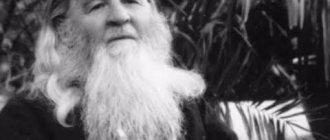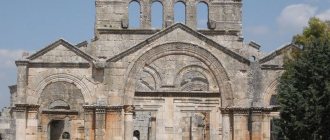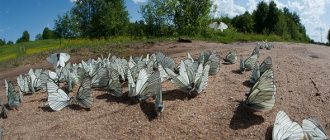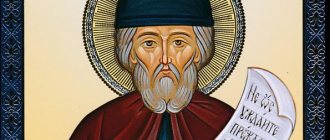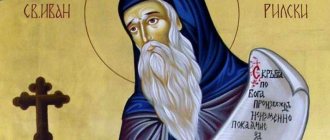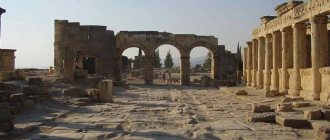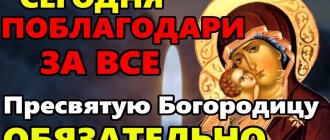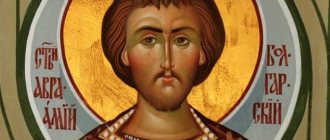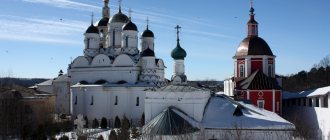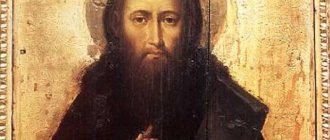Hieromonk Vasily (Roslyakov). 32 years
Father Vasily in the world bore the name Igor Roslyakov. He was born in December 1960 in Moscow. Tall, stately, strong. Igor played for the USSR national water polo team for several years. Graduated from the Faculty of Journalism of Moscow State University.
One day, on the advice of a friend, I found myself in church, because everyday troubles did not allow me to calm down. Visiting church changed Igor; he believed, began to pray, and fasted, although he continued to play sports.
An important milestone in Igor’s life was a meeting with Archimandrite Ivan Krestyankin, who, after conversations with the young man, advised him to leave worldly life and take monastic vows. Roslyakov ended up in Optina Pustyn in 1988.
The monastery was in ruins, the monks had to work a lot, performing various obediences. Igor took monastic vows, then became a hieromonk under the name Vasily. His mother, who came to Vasily, complained about his decision and persuaded him to return to the world.
According to the recollections of the inhabitants of the monastery, parishioners and pilgrims, Vasily was a modest man, taciturn, constantly focused on prayer. There was a sense of enormous inner work and disdain for worldly joys in him.
The Holy Father read a lot and obeyed the monastery chronicler. Parishioners and residents loved Vasily’s sermons. Everyone saw his deep concentration and did not distract him with idle questions and conversations.
Red Easter in Optina Pustyn
In memory of the three Optina new martyrs...
“Pray for the monks - they are the root of our life. And no matter how the tree of our life is cut down, it will still give green shoots as long as its life-giving root lives.”
Archimandrite John (Peasant)
Early on Easter morning, April 18, 1993, in Optina Pustyn, three inhabitants of the monastery - Hieromonk Vasily, Monk Trofim and Monk Ferapont - suffered martyrdom.
Hieromonk Vasily – Igor Roslyakov (born 1960)
arrived in Optina on October 17, 1988. On August 23, 1990, he was tonsured a monk, and 3 months later he was ordained a hieromonk.
Monk Trofim – Leonid Tatarnikov (born 1954)
came to Optina in August 1990 and found here what his soul had been looking for for a long time. Six months later he was accepted into the ranks of the brethren, and on September 25, 1991 he was tonsured a monk.
Monk Ferapont - Vladimir Pushkarev (born 1955)
. He came to Optina on foot in the summer of 1990. On Kiriopaskha (author’s note: if Easter coincides with the feast of the Annunciation (April 7), then it is called Kiriopaskha - the Lord’s Easter) in 1991 he was dressed in a cassock, six months later - on the Intercession of the Virgin - tonsured a monk.
19 years have passed since three Optina inhabitants were brutally murdered. These were holy people, monks, who labored diligently in fasting and prayer. Why were they killed? Because they were faithful children of our Lord Jesus Christ. When during interrogation the killer was asked about the reason for the murder, he frankly admitted that through the death of these innocent brothers he wanted to hurt God.
April 18, 1993, Easter morning
"The brothers were killed"
During the early Liturgy on the day of the Holy Resurrection of Christ on April 18, 1993, novice E. did not even run into the skete church, but rather crawled in, deafening everyone with the terrible news: “They killed the brothers!” Soon all of Orthodox Russia learned: after the night Easter service, the hand of a Satanist with a 60-centimeter knife with the engraving “666” interrupted the lives of three Optina monks: Hieromonk Vasily (Roslyakov), monk Trofim (Tatarnikov) and monk Ferapont (Pushkarev).
Before the murder. By six o'clock in the morning the monastery courtyard was empty. Everyone went to their cells, while others went to the early liturgy at the monastery. Abbot Alexander was the last to leave for the monastery, turning around at the sound of his heels; Monk Trofim was quickly running down the wooden stairs from his cell.
Hegumen Alexander recalls:
Monk Trofim was very joyful. “Father,” he says, “bless me, I’m going to call.” I blessed and asked, looking at the empty belfry:
- How are you going to call alone?
- It’s okay, someone will come up now.
How I was drawn to go to the belfry with him! But I didn’t know how to call - what good was I? And I had to go serve in the monastery.”
In search of bell ringers. Trofim looked into the temple, but they were not there. Pilgrim Elena was cleaning the temple, tired to the point of despondency after a sleepless night. But the monk could not see the despondency of his neighbors. “Lena, come on!..” - he didn’t say “call”, but pretended to do so. And he raised his hands to the bells so jubilantly and joyfully that Lena, beaming, followed him. But someone called to her from the depths of the temple, and she lingered.
From the porch of the temple Trofim saw the monk Ferapont. It turns out that he was the first to arrive at the belfry and, not finding anyone, decided to go to his cell. "Ferapont!" - Monk Trofim called out to him. And the two best bell ringers of Optina stood at the bells, glorifying the Resurrection of Christ.
The first to be killed was the monk Ferapont. He fell, pierced through with a sword, but no one saw how it happened. In the monk’s workbook, they say, there is one last entry left: “Silence is the secret of the future century.” And just as he lived on earth in silence, so he left as a quiet Angel into the next century.
Following him, the soul of the monk Trofim, who was also killed by a blow to the back, flew to the Lord. The monk fell. But already killed - wounded to death - he truly “rose from the dead”: he pulled himself up on ropes to the bells and struck the alarm, swinging the bells with his already dead body and immediately falling lifeless. He loved people and, already in death, rose up to defend the monastery, raising the alarm in the monastery.
The bells have their own language. Hieromonk Vasily was going to the monastery to confess at that time, but, hearing the alarm call, he turned towards the bells - towards the murderer.
In the murder, everything was taken into account except this great love of Trofim, which gave him the strength to sound the alarm in spite of death. And from this moment on, witnesses appear. Three women went to the farmstead for milk, and among them was the pilgrim Lyudmila Stepanova, now the nun Domna. But then she first came to the monastery, and therefore asked: “Why are the bells ringing?” “They glorify Christ,” they answered her. Suddenly the bells fell silent. They saw from a distance that Monk Trofim had fallen, then with prayer he pulled himself up on the ropes, struck the alarm several times and fell again.
The Lord gave everyone their own reading before Easter. And Lyudmila read the day before how graceful death is when they die with prayer on their lips. She heard the last prayer of the monk Trofim: “Our God, have mercy on us!”, thinking like a book: “What a good death - with prayer.” But this thought flashed unconsciously, because no one was thinking about death at that moment.
It was a peaceful Easter morning. And the thought of murder was so alien to everyone that a military doctor who happened to be nearby rushed to perform artificial respiration on the monk Ferapont, believing that his heart was bad. And from under the robes of the prostrate bell-ringers, blood had already appeared, flooding the belfry. And then the women screamed terribly. Actually, all this happened instantly, and in the confusion of these minutes the last words of the monk Trofim were heard in different ways: “Lord, have mercy on us!”, “Lord, have mercy!” Help".
At that moment, everyone’s attention was focused on the blood-stained belfry. And someone, just out of the corner of their eye, noticed how a certain man was running away from the belfry towards the utility yard, and towards Fr. A “pilgrim” in a black overcoat is running towards Vasily. How Fr. was killed. Vasily, no one saw, but he was also killed by a blow to the back.
Once in his youth, Fr. Vasily was asked: what is the worst thing for him? “A knife in the back,” he replied. A knife in the back is a sign of betrayal, because only one of your own can come so close in a friendly way during the day to treacherously kill you from behind. “The Son of Man will be betrayed,” says the Gospel (Mark 10:33). And Judas, who betrayed Christ, was also a werewolf, acting under the guise of love: “And when he came, he immediately approached Him and said: “Rabbi, Rabbi!” And he kissed him” (Mark 14:15).
Optina lamps. What were they like?
It seemed that they were no different from the other brethren of the monastery. However, the inner life of those who leave the world and devote themselves only to the One Master and Our Lord Jesus Christ is a mystery, unknown even to those close to them. And therefore, it is no coincidence that the Lord chose them to receive the crown of martyrdom - “the greatest happiness in this earthly life” (St. John Chrysostom).
What were they like? The silent prayer book monk Ferapont. Loving, reliable, jack of all trades, Monk Trofim, whom those who knew him affectionately called Trofimushka. Focused, self-absorbed hieromonk Vasily.
They came to God in different ways, but each had that moment when the soul suddenly knew the Truth, about which the future monk Trofim, overwhelmed with the joy of revelation, once exclaimed: “FOUND!”
Brother Ferapont - only to the monastery
The young Siberian Vladimir Pushkarev, who was destined to later become the monk Ferapont, came to the monastery in June 1990, and came from Kaluga on foot.
In the old days, there was a pious custom to go on pilgrimage on foot, so that in the hardships and hardships of the journey one could endure penitential labor.
From Kaluga to Optina 75 kilometers. And the Siberian came to the monastery already at night, when the gates of the monastery were locked. They noticed the wanderer when they saw how he bowed to the ground in front of the Holy Gates and froze, prostrating himself in prayer. When they opened the gates in the morning, they saw that the wanderer was still on his knees, crouching to the ground and bowing down.
Vladimir was dressed in a cassock and became a monk Ferapont on the day of remembrance of the forty Sebastian martyrs, on that day Father Vasily said in a sermon: “The blood of the martyrs is still shed for our sins. Demons cannot see the blood of martyrs, for it shines brighter than the sun and stars, scorching them. Now the martyrs are helping us, but at the Last Judgment they will convict us, for until the end of the age the law of blood applies: give blood and receive the Spirit”...
Monk Ferapont was little known even by those who lived with him in the same cell. At one time Fr. was a fellow priest. Ferapont's bell ringer Andrei Suslov, and everyone asked him: “Tell me something about Fr. Feraponte." “What should I tell you? - Andrei was perplexed. “He prayed all the time in his corner behind the curtain.” I prayed and prayed - that’s the whole story.”
The monk Ferapont had such a thirst for prayer that even long monastic services could not satiate it. One nun told how, when she was a pilgrim, she once saw Fr. kneeling under the wet snow. Ferapont. Half an hour later, looking out the window, she found the same picture, noting that the monk was regularly fingering his rosary. Incredibly, two hours later she saw him again, prostrate in prayer, already covered in snow.
The Lord loves us all, but love is responded to in different ways. And the most striking thing in the Siberian’s story is his response to grace: immediately after conversion, the path of an ascetic ascetic begins, having abandoned all care for earthly things.
From now on, he lived only by God and wanted one thing - to be with Him. Some seek earthly mercies from the Lord, some heavenly blessings, and the monk Ferapont prayed to the Savior for the forgiveness of sins throughout his short monastic life. “You will not see me on this earth again until I am forgiven by God,” he said before leaving for the monastery, and the feat of his life is a feat of repentance.
In the last days of Lent, before his death, this silent man did not go to bed at all. I prayed at night.
He took the secret of his intense prayer life with him into eternity, but they remembered his words: “Yes, our sins can only be washed away with blood.”
Brother Trofim is a hot man
The monk's worldly name was Alexei Tatarnikov. But through the years it seems that he was born Trofim and was born precisely in Optina, becoming as integral to it as the sky above the domes, the centuries-old pines, the temples, the river.
He was a hot man. He had no gap between word and deed. For example, a certain brother meets Trofim and begins to talk about how he should make a shelf for icons in his cell, but he doesn’t know how or what these shelves are made of. “I’ll think about it now,” Trofim answers. And he immediately comes to his brother’s cell with a hammer and plywood, making a shelf without delay.
He couldn't put it off. And if Trofim traveled from distant Siberia to Optina with the thought of monasticism, then this monastic life had to begin not in the distant future, but certainly today, in the morning.
From later times there is a known case when the monk Trofim went to ask to be tonsured a monk as soon as possible. “Or maybe you should be tonsured into the schema right away?” - they asked him. - “Father, I agree!” In general, the “schemnik” was immediately shown the door.
“Trofim was the spiritual Ilya of Muromets, and he generously poured out his love on everyone in such a heroic way that everyone considered him their best friend. “Me too,” one worker Vladimir recalled about the monk Trofim.
“He was everyone’s brother, helper, relative,” Abbot Vladimir spoke of him.
“Trofim was a true monk - secret, internal, and there was not a shadow of external piety and pharisaism in him... He loved God and all people!.. There were no bad people on earth for him,” said another pilgrim.
The monastery knew in advance that as soon as Trofim was sent to the city to plow the garden of a lonely old woman, all the lonely grandmothers would come running to his tractor, and he would plow it all the way. “Trofim,” they warned him, “it’s the tractor’s turn.”
First, we will plow the gardens of the monastery workers, and then we will try to help the rest.” And he honestly went to obedience. But here, at the sound of Trofimov’s tractor, such a weak old woman’s army gathered that the heart sank with pain at the sight of eyes watering from old age. And old age cried out: “Trofim, son, my idol has stolen my entire pension again. No firewood! There are no powers! To live, son, there is no urine! How these grandmothers loved their son, and how he loved them like a son!
It used to be that they would send him a translation from home, and he would buy his grandmothers handkerchiefs as a gift: white, simple, with flowers on the border. And there was no price for these scarves - there is a woolen scarf in the chest from my daughter, there is a synthetic one from my son-in-law, and simple Trofimov’s scarves were saved for death and worn only to church. He blessed these scarves on the relics, and the scarves were called “saints.”
In Trophim there was an indomitable desire for a goal - only Optina and only monasticism. And the Lord erected an obstacle on the way, perhaps enlarging the goal: not just to enter, as many enter Optina, but to be a worthy pet of it.
And no one during his life knew that Monk Trofim was a secret ascetic, but a joyful ascetic and demonstrating with his life that triumph of the spirit over the flesh, when, in the words of St. right John of Kronstadt, “the soul carries its body.”
Brother Vasily is a silent man
Father Vasily, in the world Igor Roslyakov, is a talented journalist (graduated from the Faculty of Journalism of Moscow State University). A budding poet. Famous athlete, master of sports, European champion, captain of the Moscow State University water polo team. And just a boy from an unbelieving family, where God was practically not remembered... The Lord endowed him with many talents.
In the monastery they don’t ask or tell about the past. And all that was known about Igor was that he was a diligent, silent and modest man to the point of inconspicuousness.
Hegumen Vladimir recalls: “At the potato partition we sat in a circle - conversations, jokes. They were young! And Igor will sit aside, put three buckets in front of him and work silently.”
“There is one God and one soul - that’s a monk,” he writes these days in his diary the words of St. Theophan the Recluse. But this powerful work of the spirit was hidden from everyone. There was so little external in Igor’s life that, now turning over in memory the vivid oral chronicle about the first inhabitants of Optina, you are surprised to discover that the name of Igor Roslyakov is absent from it and is not mentioned even in the well-known story about the masters of sports.
In a word, he was obedient in his novices, efficient in his assigned work, and so reliable at work that they remember, for example, something like this. Brother Igor comes out of obedience, having spent the night on duty, and Father Housekeeper comes towards him: “Igor, the bricks have been brought - there is no one to unload. Will you go?" - “Bless.”
Finally, the brick is unloaded and you can go and rest. But then the foreman of the pilgrims announces: “The Father Viceroy has blessed everyone who is free from obedience to go sort out the potatoes.” And Igor calmly goes to harvest potatoes, not finding it necessary to explain that after night duty, according to Optina rules, he has the right to rest.
Abbot Vladimir recalls: “He moved forward powerfully, like a cruising ship, but always in the middle, royal way.”
The surviving diaries and poems reveal him to be a man amazingly capable of words. His last diary ended with the entry: “By the Holy Spirit we know God. This is a new organ, unknown to us, given to us by the Lord to know His love and His goodness... It’s as if you were given wings and told: now you can fly around the universe. The Holy Spirit is the wings of the soul." Is it really possible to write like this without knowing?
From his youth Fr. Vasily devoted himself to working on the word, and after meeting the Word, born of the Holy Spirit, all the words of earthly wisdom immediately faded for him. From now on, the goal of life was already different: “I have renounced everything and count everything as rubbish, in order to gain Christ” (Phil. 3:8). And along this path, the gift given to him by the Lord gradually matured. He rejected the spiritual for the sake of the spiritual. But still he was drawn to write, and at first the lines occasionally appeared in his diary:
What, monk, took up poetry?
Or is the Psalter not enough for you?
Or the Gospel line
Are there not enough hot tears for you?
“His life was such a rapid ascent to God,” recalls the icon painter P., “that there was a chill in his soul: what if he fell on the steep side?” Upon learning of the murder of Fr. Vasily, this icon painter exclaimed in shock: “Father, you have reached it. You won, father!
Easter April 15, 1990. Father Vasily in the center
Parishioners of the Optina Metochion in Moscow asked Fr. Vasily: “Father, do you have any of your most cherished desires?” “Yes,” he answered. “I would like to die on Easter with the bells ringing.” It came true.
Three crosses, like three siblings,
They stand surrounded by silence.
Crucified in their graves for the Lord,
Three Optina monks are lying down.
Hieromonk Vasily, monk Trofim and monk Ferapont - all three were true monks, secret, without pharisaism. People of prayer, strict fasters and ascetics, especially during the last period of their lives, Great Lent. And, according to testimonies, all three guessed about their imminent departure, being already prepared for it through many prayerful works and climbing a steep spiritual ladder. That is why they were chosen - no, not by a murderer, but by the Lord - to play the role of the three-numbered (in the image of the Holy Trinity) new martyrs of Optina, powerful, as it turns out, heavenly intercessors for the monastery and all of Russia...
For 19 years now, every year on April 18, representatives from all over Russia gather in Optina and Kozelsk for the days of remembrance of the Optina New Martyrs. The Optina priest said:
— We lost three monks, but gained three Angels
Holy New Martyrs of Optina Basil, Trophim and Ferapont, pray to God for us!
The material was prepared based on Nina Pavlova’s book “RED EASTER”
Photos taken from the official website of Optina Pustyn
Donate
April 18, 2012
#churchlife
Share on social networks
Monk Trofim (Tatarnikov). 39 years
Leonid Ivanovich Tatarnikov is from the Irkutsk region. In his youth, he graduated from the railway school and was a machinist for several years. Then he changed his field of activity - he went to sea on a fishing boat. He was interested in photography and folk dancing.
Leonid was a person with many interests, often changed professions - he worked as a shoemaker and cattleman. Then fate brought him to Altai. Here he came to faith and decided to make a pilgrimage to Optina Pustyn. In 1991 he was accepted into the brethren and named Trofim.
Having become a monk and having found his calling in monastic life, Trofim said that he was grateful to the Lord for science and the opportunity to apply his rich experience for the benefit of people and the Holy Church.
The monk was famous for his fortitude; during Holy Week he refused food, continuing to carry out his work. He worked as a cattleman, managed the settlement of pilgrims, was a blacksmith and a plowman. Trofim, performing many duties, sometimes received penance from his mentors for flaws in his work. The monk always accepted them humbly, understanding that he had sinned and deserved punishment from the Lord.
Trofim wrote to his family that he was just learning to be a monk, and urged them to give up money-grubbing, forgive each other and pray for him.
Iconography of the king
A separate question of modern iconography of the new martyrs: how to depict Tsar Nicholas II? Some are of the opinion that he should be written as he was already dressed in exile: in military clothing without shoulder straps and other military insignia. But the saint is not always depicted as he looked in the last years of his life, in the hours immediately preceding his martyrdom.
Saint Nicholas the Emperor, Sergiev Posad
This approach is completely unacceptable, because many holy martyrs spent years and decades in prisons and camps before being executed, such as, for example, the successor of St. Tikhon, Patriarch of Moscow and All Rus', Metropolitan Peter of Krutitsky: this is the First Hierarch who led the Church for 12 years, He spent 11 of them in captivity, and was shot there in distant exile. In the last years of their lives, these sufferers, of course, not only did not wear liturgical episcopal or priestly vestments, but they also did not have monastic vestments; perhaps they were mockingly or simply shaved in the infirmary, like the Hieromartyr Hilarion, Archbishop of Verei. For hagiographical icons, when a specific event is depicted, such images may still be possible, but not for prayer icons of a saint - be it a separate image or in a cathedral of saints.
Of course, there are bishops who are depicted everywhere in episcopal vestments - like St. Nicholas the Wonderworker. Even on the stamps telling how he walks through the sleeping city at night to throw another bag of gold at the window of his desperate father. Of course, Saint Nicholas hardly did this, being dressed as for serving the liturgy: in a phelonion, with an omophorion. Of course not! But that's how they write it. He is completely special; people sometimes even called him “Russian God.” This chosenness is emphasized, in particular, by such irremovable signs of episcopal distinction. But such saints are few. Even St. John Chrysostom in the hagiographical marks can be depicted in simple monastic vestments: in a cassock and mantle.
Therefore, by analogy - it does not matter that in recent years Tsar Nicholas did not wear royal clothes - we glorify him as a passion-bearing king. We do not glorify him as the martyr Nicholas, who was once also a tsar. And as we glorify, we also depict: he is a king, he accepted torment - this is reflected in the icon.
In connection with painting the image of Tsar Nicholas, the following question arises: in what clothes should he be painted - in coronation clothes (in an ermine robe) or in the festive traditional clothes of Russian sovereigns, in which we see him in photographs of the celebrations of the 300th anniversary of the Romanov dynasty? I think that the latter is more correct, because this was an ideal for him: the holy Tsar Nicholas was very fond of medieval Rus', which it was then that acquired the name Holy. Most likely, if the dynasty had continued, then the coronation clothes would have changed in accordance with these ancient models. Therefore, this iconography appeals to me more; it seems more accurate in relation to the memory and glorification of the king.
Martyr Elizabeth of Zvenigorod
There are many more different questions: are a person’s height, age, etc. taken into account or not when painting an icon? Let’s say that when depicting the royal family, they often write the king and queen of the same height, and the children are smaller, but also approximately the same height, although in fact this was not the case: the princesses were already adults, and some of them were already the same height as their parents , and among themselves some of the older ones were taller, the younger ones were lower. So there may be more realistic images, where, checking with known photographs, the icon painter describes the existing difference in the height of the royal children. Although you can symbolically show that there are parents, and there are children. It is typical for an icon to indicate this difference.
Monk Ferapont (Pushkarev). 37 years
Vladimir Pushkarev is also a Siberian, born in the Novosibirsk region. He played the guitar well, and in his youth he was cheerful and lively. Then he trained as a forester and worked for 3 years as a gamekeeper in the Khabarovsk Territory, living as a hermit in the forest in complete solitude.
Then he moved to Rostov. Here for the first time I thought about faith, the impetus was meeting a woman who almost died in an accident. On the advice of a friend, Vladimir began reading spiritual books and going to church.
Having been a pilgrim to the Optina Hermitage, Pushkarev decided to become a monk and said goodbye to all his loved ones. Since 1990, he began to live in the monastery and took monastic vows under the name Ferapont.
The monks called him the angel of silence. Ferapont surprised all the inhabitants and laity with his quiet disposition, good nature and constant immersion in prayer. I read a lot, made extracts from books, and hung them in my cell. He had little contact with his brethren, but no one considered him proud.
Ferapont cooked in the refectory, could make any craft from wood, carved crosses, and was a skilled bell ringer. The monks recall that before Easter, Ferapont, as if knowing that his days were numbered, gave away his working tools and belongings.
Nikolay Averin
Nikolai Averin killed three monks in Optina Pustyn. He was born in 1961 near a monastery in the Kaluga region. In 1990, at the age of 29, he became known to the police - a certain woman filed a complaint against Averin for rape. But the case did not go to trial, as the victim refused the charges.
A year later, Averin’s victim was another woman, whom he not only raped, but also brutally beat. After a forensic psychiatric examination, the man was declared insane and placed in a clinic. A year later, the killer was released from the mental hospital, having been recognized as a 3rd group disabled person. Averin returned to his homeland in the village of Volkonskoye.
After the tragedy, details of Averin’s preparation for the murder of monks were revealed. The man had stocked up in advance on the black sailor's overcoats that the brothers wore. He grew a beard so that he could be mistaken for one of the monks.
Averin came to the courtyard several times, spent a long time following the movements of the bell ringers and other monks, examined all the entrances and exits, studying the escape routes from the monastery.
Facial recognition
One of the most difficult tasks in icon painting is to create an image that is truly iconographic and at the same time recognizable. How similar should the face be to the face of a specific person, our almost contemporary, who became a saint?
Even ancient saints are recognizable on the icons: the same St. Nicholas, the images can be fundamentally different in execution, but the face is always recognizable. Moreover, even those to whom St. Nicholas appears as if in reality, then recognize him in the icons, even if they have never seen his icons before and found themselves in the church for the first time.
With regard to the new martyrs, the requirements for similarity increased significantly. If a saint of the 20th century, known from photographs, does not resemble himself in the icon, then he will not be recognized. This can be confusing and become an obstacle to praying in front of such an icon.
The problem of similarity is also relevant for portrait painters. And in an icon, this similarity of features, and most importantly, some always difficult to catch facial expression, is all the more difficult to achieve: on the one hand, the image of the saint had to resemble himself, and on the other, correspond to the iconographic tradition. It happens that an icon painter works, say, in the tradition of the 16th century, and the entire image is made in this vein, and the face is painted semi-realistically, since the icon painter could not achieve recognition in any other way. This is definitely a drawback.
Saint Tikhon
Often the appearance is depicted as close as possible to the appearance of the saint, especially if photographs remain or they are widely distributed, as in the case of the royal family, the Martyr Elizabeth and other famous saints. Of course, the icon will be assessed from the point of view of the correspondence of the faces to the faces.
The problem of painting an icon of a saint who does not have any photographs or portraits left is a rather complicated problem. Then, as far as it is possible to find out, they will find out what he looked like from available indirect sources, and, having prayed, begin to work on the image.
Murder investigation. Averin's arrest
The police arrived at the monastery after the news of the death of the monks. Father Vasily died in the hospital. The brethren bitterly regretted that attempts to save the wounded man were not crowned with success; Vasily was taken out in vain, not allowing him to retire peacefully in the monastery, which the hieromonk dearly loved.
Before the examinations were carried out, the police suspected the murder of the monks, since Averin skillfully disguised himself as inhabitants of the Optina Pustyn. Several people from the brethren were arrested. The press wrote poisonously about drunken Orthodox Christians who stabbed to death monks.
Averin hid for some time in the Tula region, where he managed to commit theft. Then the killer returned to his native village. Averin threw the knife in the monastery, he was exposed by fingerprints on the murder weapon.
The arrested Averin did not lock himself away, he was even proud of what he had done, and spoke in detail about the murder of the monks. A hastily conducted examination found him insane and sent him to a hospital. Averin was diagnosed with schizophrenia, and the case was closed.
Orthodox Christians and brethren who loved the murdered monks are confident that the investigation was conducted poorly. Witnesses, to whose words the police did not pay much attention, claim that Averin had accomplices or inspirers. While in the monastery, they observed the actions of the killer; many saw them and could identify them.
According to Averin's fellow villagers, shortly before Easter he suddenly became rich - he drank himself and treated his friends, although he usually had no money. In preparation for the murder, Averin demonstratively sharpened the knife, willingly showed it to his friends and promised to “cut” the monks.
The investigation did not try to identify any connections of Averin; the criminal was designated as an insane loner. Averin's fate is unknown; his death or release from the psychiatric hospital was not reported.
How are icons of the new martyrs painted?
In the work of an icon painter, prayer to the saint whose image is being created is extremely important. In addition, before starting icon painting, they pray to the Lord, the Mother of God, Alipius the icon painter, Andrei Rublev and other holy icon painters. Now the new martyrs and icon painters have also been glorified. We must ask God and them for help.
Before starting work on the image, you should always study the life of the saint. Feel his feat. Collect all available visual material: photographs, portraits. If there are none, some additional sources may be involved: memories of this holy man of people who knew him, relatives. In the history of icon painting, there are cases when an icon painter prayed to a saint whose appearance he did not know, and the saint appeared to him so that when he saw him he could paint an icon.
It is important for every icon painter to feel the depth of the ascetic’s life in order to transfer this depth to the icon, thus revealing the heavenly world, so that through the icon the people may be churched and enlightened.
Icon and prayer
Three of the Optina New Martyrs are depicted on the icons – Father Vasily in the center, monks Trofim and Ferapont along the edges. The monks are depicted in the clothes prescribed by the monastery charter. Image options:
- with a cross - a symbol of martyrdom in his hands;
- with Easter cakes and eggs, since the monks died on Easter Day;
- Trofim and Ferapont are holding Optina Pustyn in their arms;
- the monks' feet are hidden in the clouds.
Consecrated icons depicting new martyrs can be purchased in churches. The monks of Optina Hermitage who were killed on Easter Day are often approached with prayer requests.
Prayer text
O venerable and ever-memorable martyrs for Christ our Savior, venerable fathers of Optinstia: Basil, Trophime and Feraponte! Hear this prayer of ours, O wonderful sufferers who are now beholding the Most Holy Trinity! Ask us from the Lord Almighty for patience and gracious reinforcement in various sorrows and illnesses, quenching of passions, peace and silence for our hearts. For the Lord will soon bow to your intercession, before Whom your martyr’s blood shines like a scattering of diamonds and smells more fragrant than incense. She, saints of God, favorites of Christ, do not abandon us, but always guide us on the true path. And may the spirit of Antichrist not enter into us through your prayers during the days of fierce trials. And may your prayers be worthy of ushering us into the Imperishable Halls of the Kingdom of Heaven, where together with you we will glorify and sing the honorable and magnificent name of the Father and the Son and the Holy Spirit, now and ever and unto the ages of ages. Amen.
Icons of the new lay martyrs
When painting icons of the new lay martyrs, a problem arises: what clothes to paint them in. If a layman was a reader, psalm-reader, or altar server, he can, of course, be depicted in a surplice, and this makes the task easier. And if not, then how can modern clothes be beautifully painted on an icon?
With the painting of images of the new martyrs, the situation is somewhat simpler, at least in terms of depicting clothing - it has not undergone such strong changes for women since the Middle Ages. Until the beginning of the 20th century, it more or less corresponded to the models that tradition had, so it can be written by resorting to already tested techniques. And it is very difficult to depict modern men’s clothing in an iconographic manner.
Sometimes when painting an icon, some archaization of clothing is used. Although a more realistic rendering of the same jackets and shirts is possible. At the same time, it is necessary to ensure that no matter how modern the clothes are depicted, so that in the end they look harmonious and beautiful. At the same time, I would not recommend getting carried away with reproducing the realities of clothes down to the details. For example, Blessed Ksenia of Petersburg in the icon is dressed in her husband’s jacket, depicted conventionally, and this is a very convincing image.
Meticulously painted details are not important in an icon. The main thing is to create an image, to capture the most characteristic. For example, when depicting a temple, it is not necessary to draw all the elements; it is enough to give an image of the building so that it is immediately clear: this is such and such a temple. Or, let’s say, you don’t need to paint down to the insignia of the uniform of the Red Army soldiers shooting the new martyr on the mark of the icon, you can simply show some executioners with guns in conventional clothes, it is important that the meaning of what is happening is clear at first glance. Not every icon painter can do this.
How does prayer to the Optina New Martyrs help?
The canonization of the murdered monks has not yet taken place. But many miracles have already been documented, revealed through prayers to the new martyrs. In prayers they ask:
- about strengthening faith, assistance in spiritual development;
- about finding the right path, solving complex problems;
- about the gift of courage and perseverance in the face of difficult trials;
- about health for yourself and your loved ones.
You can ask for help in any everyday problems or good deeds. The monks who suffered martyrdom were kind, sympathetic people who had gone through a difficult path in life. Prayers to the New Martyrs of Optina Hermitage from the heart and with hope turn out to be effective and help solve many problems.
The monks of Optina Hermitage died on Easter Day. Their monastic journey was short and ended with martyrdom. All three came to Orthodoxy in different ways and found faith in a country that had gone through difficult years of persecution of the church. The Optina monks have not yet been canonized, but are revered by all believers who are confident that the brothers pray to the Lord for all of us and help us in difficult times.
Cathedrals of Saints
The image of the cathedrals of saints is important - these can be the cathedrals of Moscow, Perm, Ryazan, Penza and other lands, the cathedrals of the new martyrs of these lands. This is simply necessary in the event of establishing a day of remembrance for the cathedral. A city cathedral can also be written separately, so that every believer in the city, for example, can say: “Here in our city such and such saints labored!” This is the property of the citizens of this city. When there is an icon of holy fellow countrymen, it inspires. This is a kind of holy immortal regiment of the area - the history of our family, our city.
They also write cathedrals of saints, for example, the Moscow Theological Academy, St. Petersburg, etc. There is even a cathedral of saints at Moscow State University. This gives a completely different feeling, a color of experience just from being within these walls where the saints studied.
